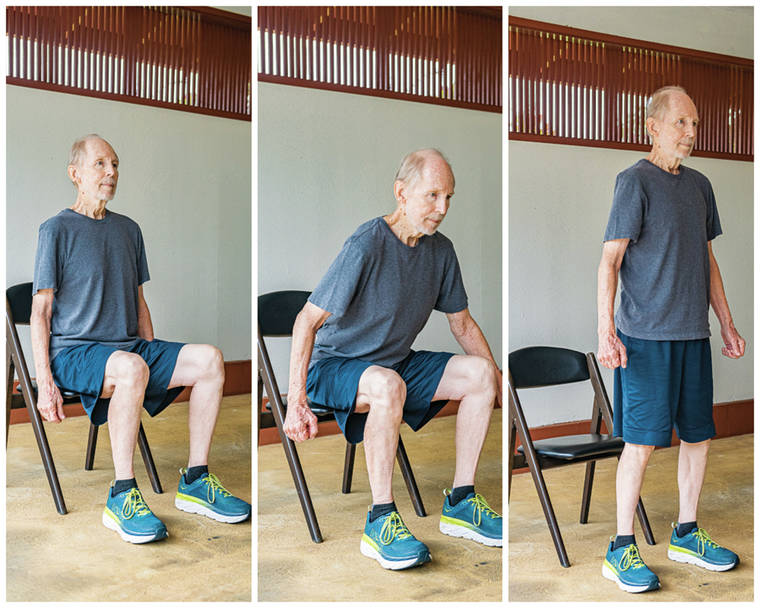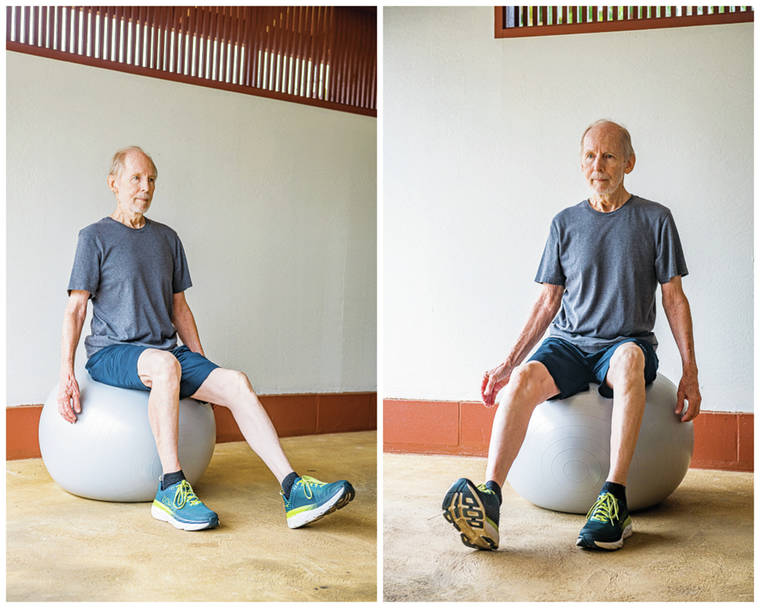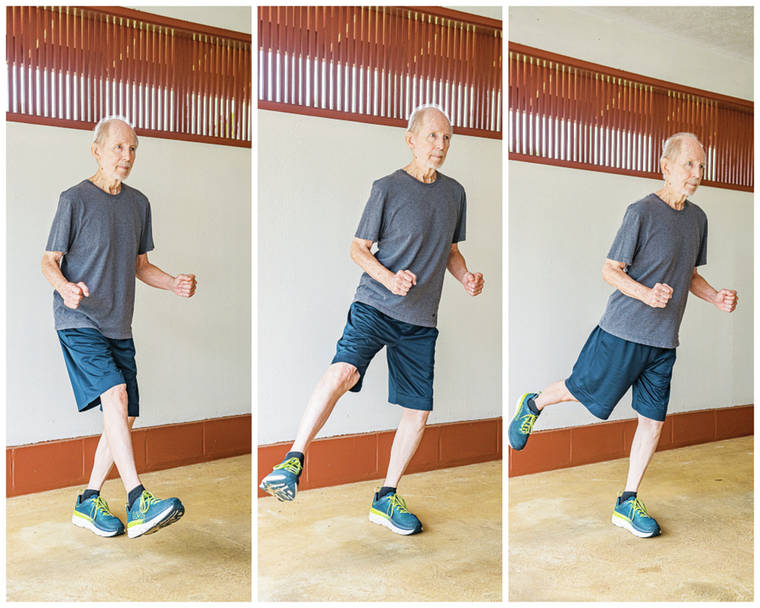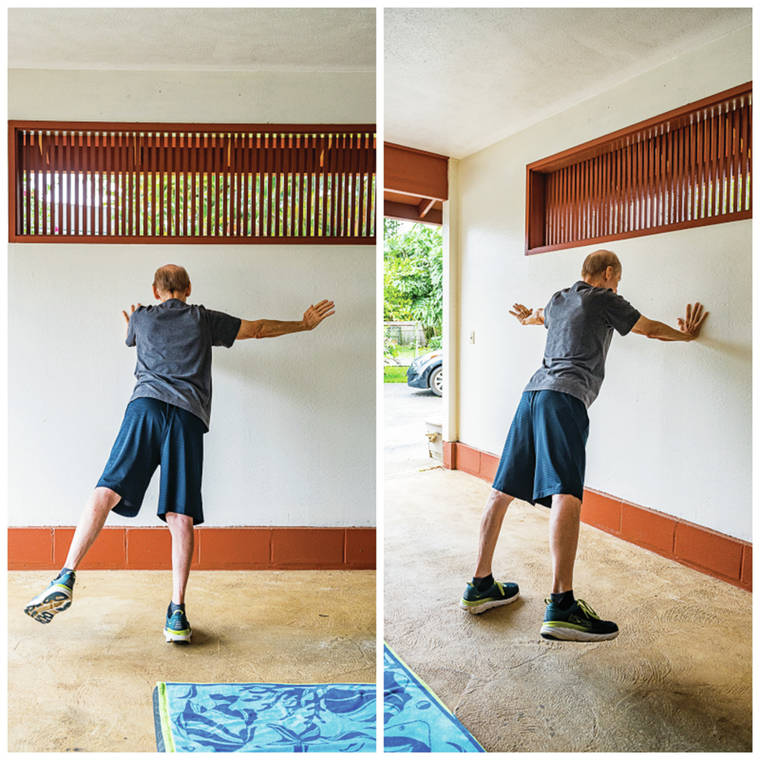‘At Risk’ and in shape!

Aaron Feinberg / Contributed photo
Gerald Browne of Kapaʻa performing a sit-to-stand

Aaron Feinberg / Contributed photo
Gerald Browne of Kapaʻa using a stability ball for balance training

Aaron Feinberg / Contributed photo
Gerald Browne of Kapaʻa performing a balance reach in 3 directions

Aaron Feinberg / Contributed photo
Gerald Browne of Kapaʻa using the wall to build lower body strength

Aaron Feinberg / Contributed photo
Gerald Browne of Kapa’a using the wall to perform a balance reach in plank.
The phrase “at risk” has been used to refer to people over the age of 65 who are at increased risk of hospitalization and fatality due to COVID-19. The CDC states that “8 out of 10 COVID-19-related deaths reported in the United States have been among adults aged 65 years and older.”
The phrase “at risk” has been used to refer to people over the age of 65 who are at increased risk of hospitalization and fatality due to COVID-19. The CDC states that “8 out of 10 COVID-19-related deaths reported in the United States have been among adults aged 65 years and older.”
So it’s with good reason that our kupuna have been increasingly wary and cautious, while their families remain guarded and protective.
Since the outbreak, the community has responded by providing extra resources, separate shopping hours, and measures to help keep distance between those at increased risk from the virus.
However, I can’t help but wonder how our kupuna are staying physically active, mentally engaged, and generally positive under these circumstances. Many have spent more than 80% of the last 8 months at home. What resources are available to aged residents right now to make the most of this time rather than feel like a refugee hiding from the virus in at-home bunkers?
Keep moving
According to the 2019 census, 20.7 percent of the population on Kaua‘i are over 65 years old. Prior to the outbreak, there were plenty of fitness modalities for this group. Many enjoyed group exercise classes at nearby gyms and clubs. Some worked with personal trainers, exercised with friends, enjoyed aqua exercise, and took regular walks with neighbors. So much has changed.
Many fitness facilities have closed and various group activities have been discouraged or temporarily paused. While some of these are being offered again, the extra heat and breathing challenges of wearing a mask make it impossible for some to re-join these activities.
So if you consider yourself to be part of the “at risk” population, why is it so important that you stay active right now instead of waiting for things to go back to “normal”? I asked Kay Kuwamura, master trainer for EnhanceFitness Kaua‘i (an evidence-based senior fitness program offered through the County of Kaua‘i Agency on Elderly Affairs) and Group Exercise Coordinator at Kaua‘i Athletic Club, that question.
“I like to tell my seniors that sitting is the new smoking … sitting for long periods of time can be toxic for both the body and the mind. A sedentary lifestyle can have negative physical and mental consequences … like weakening of the muscles, decreased mobility and decline in cognitive function,” said Kuwamura. “If I had to prioritize, I would say the 3 most important elements are keep moving, keep moving, keep moving!”
Let’s talk about the brain
Age alone doesn’t determine brain function, but as we age the brain does lose mass and capacity. Many face extra challenges to memory and cognitive function in their older years.
The good news is that exercise has a positive effect on brain function at almost every level! For example, exercise increases the chemical compounds responsible for “building” tissue in the brain, improving the communication between nervous system cells, and regulating hormones that stabilize mood. In a group of 182 adults in the Harvard Aging Brain Study, those with higher levels of physical activity showed slower cognitive decline and slower loss of gray-matter volume (doi:10.1001/jamaneurol.2019.1879).
It is also tremendously beneficial to include mental exercise in your fitness routine. Simple sequencing exercises such as counting backwards in set intervals and spelling words backwards while performing a physical exercise can provide a fun challenge and I’ve used these techniques with clients with great success.
Preventing a fall
Independence is something we all need, but to those advanced in years, independence takes on even more importance. One of the biggest threats to independence in older age is falling.
The CDC says that “more than 95% of hip fractures are caused by falling.” Although there are various risk factors that contribute to falling, one factor that you have enormous control over is muscle strength and balance.
These can be greatly increased with simple exercises like those pictured here, done consistently. Besides the physical benefits, targeted exercise also increases confidence and the feeling of independence while decreasing fear of falling.
Less disability, more capability
Studies show that resistance training and low-impact cardio activity can reduce the pain from osteoporosis and arthritis, improve bone health, and prevent further deterioration. It is always advised that you have approval from your health care provider before beginning a new exercise program.
It’s likely that your doctor will have exercise recommendations or refer you to a professional who has experience working with these conditions. Simple flexibility and ROM (range of motion) exercises can improve daily quality of life by allowing you to complete tasks with more ease.
If the pandemic has given you more time with your grandchildren in recent months, you may be thinking of daily activities involving their care and play that you hold dear such as chasing little ones around the house. Regular exercise, even in small increments, has been shown to increase energy and stamina.
A new strategy
I asked my dear friend and client Gerald Browne, who exercises 3x weekly consistently and walks daily, how exercise has benefited him before and after the outbreak.
“Before the pandemic, I began a supervised exercise program for health reasons. The pandemic has not changed my reasons for exercise, merely the surroundings. Being in a “high risk” age group means being more reluctant to be away from home,” said Browne. This is all the more reason to exercise.”
I work with Browne using equipment set up in his garage. We maintain social distancing and I wear a mask. He is shown in these pictures demonstrating simple exercises that require little to no equipment. He walks every day and the results of that regular cardio exercise are very evident to me. His routine also includes stretching, resistance training, and balance and coordination exercises. A favorite tool is the TRX suspension trainer which can be secured in a doorway and used to train every part of the body.
Browne provides just one example of how kupuna can develop a new strategy for physical fitness.
Know your options
With regulations and suggestions changing constantly, it is up to each individual, equipped with information from your doctor, to decide what fitness strategy is best.
I can assure you that whether you decide to stay at home or join in regulated group exercise, there are still plenty of options for you!
Kuwamura gave me the scoop on current group fitness offerings at the club.
“Our facilities are taking great measures to keep our members safe during this pandemic… . in addition to mask requirements and social distancing, we have taken extra cleaning/sanitation measures, such as having an additional staff member cleaning per shift, more time between classes to allow for complete sanitation of equipment, and foggers to completely disinfect the studios and any equipment that cannot easily be wiped down,” said Kuwamura. “Honestly, this is the cleanest our facilities have ever been!”
Just at the Lihue location alone there are currently 17 weekly classes that are either specifically for our kupuna or offer modifications and options for those at any age. While the club will re-assess as needed in response to state and county guidelines, both Kuwamura and the club owner Josh Nations have been really focused on maintaining programs for seniors.
Kuwamura touched on another of the reasons for this, saying “Classes offer an important social component. During these challenging times, many are spending large parts of the day alone and social isolation can have negative effects, so it is essential that they have socially-distant contact with others.
Exercising with others can be a simple way to boost their emotional state. And this could be in person, but also virtually.” You can find the class schedules for both locations online at kauaiathleticclub.com.
Virtual and mobile training
If you have decided not to join in social settings yet, you might also consider the online world of exercise classes, as well as working with a fitness professional online via a video chat platform such as Zoom or Skype.
For example, for those eligible through Medicare, SilverSneakers has created a virtual classroom with hundreds of classes to occupy your time, along with regularly scheduled live classes.
You can check your eligibility at silversneakers.com. If you don’t consider yourself particularly computer savvy, don’t worry. Ask a friend or family member for a little assistance in finding an online platform. There are more than a few to choose from.
Consider this an opportunity to learn how to use a new tool, and build a new strategy!
“At risk” and in shape
I know we all want our aging community members to not just survive this pandemic, but THRIVE through it. I hope you feel inspired to build your new strategy, and remain determined to keep moving. Please know that you have many tools to improve your immune system function and overall wellbeing. Fun is important. Laughter is medicine. May you build your own “new strategy”, and above all, keep moving!
•••
Cynthia Fowler is a certified personal trainer (NASM), corrective exercise specialist (NASM), registered vinyasa yoga teacher (RYT 200), certified Enhance fitness teacher, group exercise instructor (TRX, indoor cycling, HIIT, SMR, etc), owner of FoundationUp Fitness, blogger and health coach. She can be contacted through her website at foundationupfitness.com or directly at Cynthia@fullyfreely.com.

